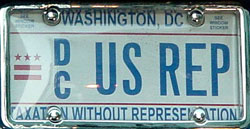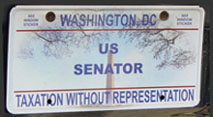License Plates for City Officials
| D.C. Council |
 The relevance and existence of most of the license plates pictured and discussed on this page is understood only when the administrative structure of the District's government is also understood. Because all of the known Washington, D.C. license plates for elected officials are of the style made and issued since the late 1960s, we will limit our discussion on this topic to this period. Brief comments about the earlier structure of the D.C. government may be found here.
The relevance and existence of most of the license plates pictured and discussed on this page is understood only when the administrative structure of the District's government is also understood. Because all of the known Washington, D.C. license plates for elected officials are of the style made and issued since the late 1960s, we will limit our discussion on this topic to this period. Brief comments about the earlier structure of the D.C. government may be found here.
Washington is presently governed by an elected mayor and an elected council, the Council of the District of Columbia. This leadership structure came into existence in 1973 with passage by Congress of a Home Rule Act for the District. The first mayor and council were elected in the fall of 1974. From 1967 through late 1974 the city was administered by a mayor-commissioner and a nine-member city council appointed by the President. From 1874 to 1967, three commissioners, appointed by the President, led the city.
License Plates for Members of the Council of the District of Columbia
The Council of the District of Columbia (the "Council") performs essentially the same functions as does the legislature of each of the 50 states. It works with the mayor as each legislature works with a governor. In addition to functioning as a legislative body, the Council also is responsible for the oversight of many agencies, commissions, and boards that comprise the District of Columbia government. The official seat of government for the District of Columbia is the John A. Wilson Building (formerly known as the District Building), located at 1350 Pennsylvania Avenue NW, at the southeast corner of the intersection with 14th St. NW.
The Council is comprised of a chairman elected at large and 12 members: one elected by residents of each of the city's eight wards, and four at large members. The term of service for council members is four years. Special license plates appear to have been made available to members of the Council since 1974, when the first Council was seated. The letter that appears on plates presently issued to at large members (e.g. the "B" on the 1991 baseplate pictured below) is believed to be a serial character, included in order to differentiate otherwise identical plates issued to the four at large members (assuming the chairman, also elected at large, always has a unique plate).
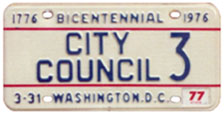 |
1974 Baseplate |
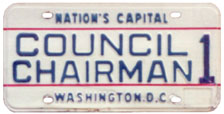 |
1978 Baseplate This particular plate appears to have been used, and is therefore accepted as being representative of a series of plates issued and used during the 6.5-year period that plates of this style were distributed: April 1974 through September 1984. |
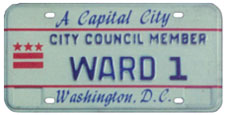 |
1984 Baseplate Although this plate appears to have not been used, we believe that it is representative of a series of plates issued and used during the 6.5-year period that plates of this style were distributed: October 1984 through July 1991. |
 |
1991 Baseplate Although this plate appears to have not been used, we believe that it is representative of a series of plates issued and used during the 9.5-year period that plates of this style were distributed: July 1991 through November 2000. |
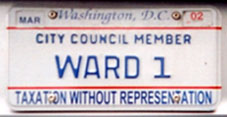 |
2000 Baseplate This is presumably the first style of plate made especially for Council members after the Taxation Without Representation slogan was introduced in November 2000. This base has since been replaced by graphic plates of at least two designs, which are discussed below. |
Recent Baseplates
Special license plates for Council members have recently been made on two distinctive graphic backgrounds: one with a dogwood-framed view of the Washington Monument, the other featuring an image of the D.C. flag. These background designs are not known to have been used on D.C. plates of any other types, and as of early 2009 they were being used simultaneously. What, if any, distinction is made between them (i.e. which style is issued to various members of the Council) and when each design was introduced is unknown.
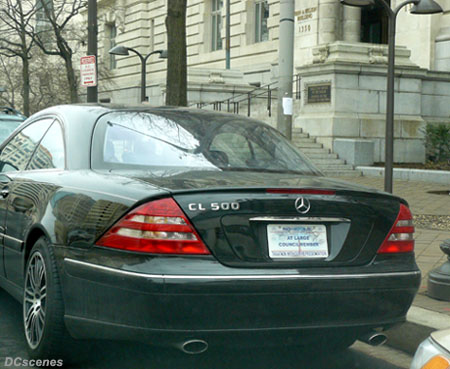 |
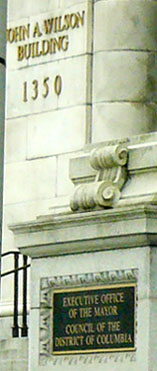 |
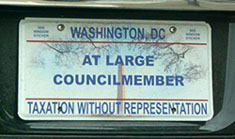 |
The District of Columbia government is based in what since its 1904-1908 construction has historically been called the District Building, although in 1994 it was named in honor of John A. Wilson, a former Council chairman and a Ward 2 councilmember for 16 years. Parked in front of the building on Pennsylvania Ave., NW, in mid-March 2009 is a Mercedes-Benz adorned with a plate that identifies its owner as a member of the Council who was elected at large. The Washington Monument background has been observed only on special plates issued to members of the Council. |
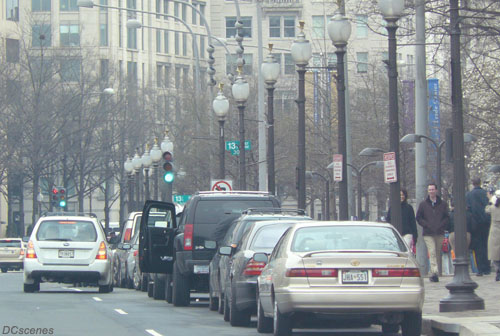 |
A Hummer H3 parked on Pennsylvania Ave., NW, is registered with an At Large Council-member plate identical to the one pictured on the Mercedes-Benz above. Why there is no serial letter or other feature to differentiate plates issued to at large members is unknown. |
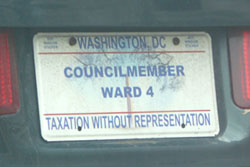 |
These two designs were in use simultaneously in early 2009. |  |
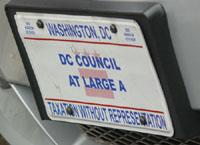 |
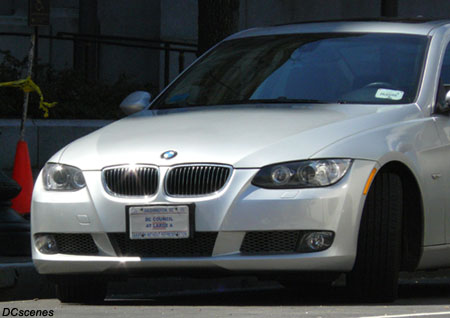 |
License Plates for Other D.C. Officials
City Council Member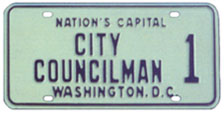 Before the current Council was created in 1974, there was a separate City Council that was created in 1967 and existed for about eight years. It was comprised of nine members, all appointed by the President. The first D.C. plates created especially for individuals responsible for administration of the city was this series of 1968 baseplates, numbered 1 through 9. Like general-issue plates of this style, these special plates were introduced at the beginning of the 1968 registration year, on April 1, 1968. Plate no. 1 was assigned to Council Chairman John W. Hechinger. Before the current Council was created in 1974, there was a separate City Council that was created in 1967 and existed for about eight years. It was comprised of nine members, all appointed by the President. The first D.C. plates created especially for individuals responsible for administration of the city was this series of 1968 baseplates, numbered 1 through 9. Like general-issue plates of this style, these special plates were introduced at the beginning of the 1968 registration year, on April 1, 1968. Plate no. 1 was assigned to Council Chairman John W. Hechinger. |
|
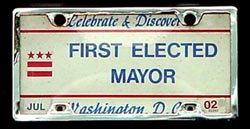 First Elected Mayor First Elected Mayor This license plate was presumably issued to Walter E. Washington, who in 1974 became the first individual to be elected mayor of Washington, D.C. since Reconstruction. He served as mayor from January 1975 through January 1979. Mayor Washington died in October 2003, making this particular plate obsolete. |
|
The D.C. Home Rule Act was passed by Congress in 1973 and approved by Washington voters in 1974, and the first Council was seated in early 1975. This plate was issued about 35 years later, apparently to recognize an at large member of the first Council. |
|
The DC State Board of Education was established in June 2007 in conjunction with an education reform act of that year. It is comprised of nine elected members, one representing each ward and one at large. When special plates were first made available to Board members is unknown, but this style was in use by mid-2011. |
|
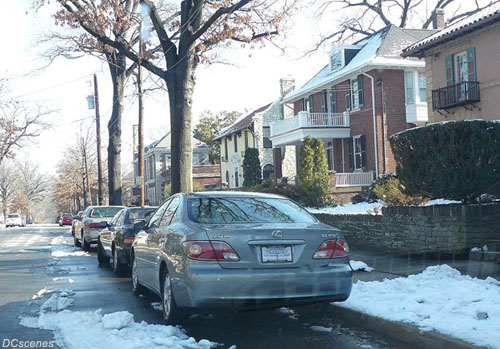
License Plates for the District's Representatives to Congress
The District of Columbia has no voting representation in Congress. However, it does have a Delegate to the House of Representatives, as well as Shadow Representatives and Senators.
Delegates to Congress. Delegates from D.C. and U.S. territories (including the Resident Commissioner of Puerto Rico) are elected to two-year terms, and although they may not vote in the full House, they may vote in House committees of which they are members. There is no equivalent position in the Senate. Some of the U.S. Territories (but not D.C) began sending delegates to Congress in the mid-1960s in an effort to seek official recognition of the position, which was granted in 1970.
The District of Columbia has had a Delegate in the House since 1971. This position was held by Walter E. Fauntroy from 1971 through 1991 (the 92nd through 101st Congresses), and Eleanor Holmes Norton has been the delegate since 1991.
Shadow Representatives and Senators. Residents of the District of Columbia and six U.S. Territories elect shadow U.S. Representatives and shadow U.S. Senators as part of their efforts to gain full admittance to the Union as states. Use of the word "shadow" in this context originates from the traditional practice of the Official Opposition appointing shadow cabinets in parliamentary systems. The first shadow Senators were elected in 1796, and the Territory of Alaska created the position of shadow Representative in 1956.
Since 1990, Washington, D.C. voters have elected two shadow Senators and one shadow Representative. Individuals that serve in these positions are recognized as U.S. senators and representatives by the District of Columbia but are not sworn or seated (i.e. are not given official recognition) by either house of Congress.
 |
|
Left An early "Taxation" (2000) baseplate that likely was used by Eleanor Holmes Norton, although due to the relatively generic inscription it could have been assigned to any of the officeholders described in this section. Right A recent plate assumed to be used by either Eleanor Holmes Norton or the present shadow Representative, Mike Panetta. |
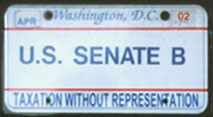 |
|
Left This 2000 baseplate is presumably assigned to the shadow Senator occupying Seat 2, our assumption being that the letter "B" is a serial character to differentiate between the two shadow Senators, and numbers presumably not having been used so as to not risk associating these at large positions with one of the city's wards. Note that this flat plate was specially made, likely using silk-screen printing, when other D.C. plates were still being made with embossed registration number characters. Right A plate in use in early 2009, presumably issued to one of the District's two shadow Senators. |
|
This page last updated on December 31, 2017 |
 |
|
copyright 2006-2018 Eastern Seaboard Press Information and images on this Web site may not be copied or reproduced in any manner without consent of the owner. For information, send an e-mail to admin@DCplates.net |














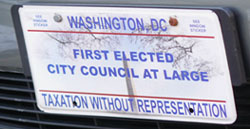 First Elected City Council At Large
First Elected City Council At Large 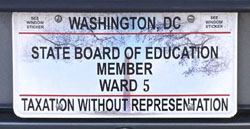 DC State Board of Education
DC State Board of Education 